
Laser Optics
The laser used in the minidisc player serves two purposes. Its primary role is to read digital information in a similar fashion as a CD player. Its secondary, but equally important, function is to supply focused heat to the minidisc itself during the recording process.

LASER HEAT: The minidisc recording system takes advantage of a discovery by Pierre Curie in the 1880's. He found that when iron is heated up to a certain temperature, now called the Curie point, it loses its magnetic properties. Similarly, when the minidisc laser is directed at a tiny point of the disc during recording, it heats that spot up to 180 degrees celsius, and the disc material loses its magnetic properties. A magnetic field can then be "frozen" onto that point once it moves past the laser beam, storing data. For more information on the recording process, visit the magneto optics section of this web site.

LASER READING: The minidisc laser can read two types of discs during playback. The first type is a pre-recorded disc, which is the same format as a CD. This disc stores data using pits stamped into the disc. When the laser passes over a pit, it is reflected 180 degrees out of phase with itself, and its light intensity is lowered. A diode that intercepts the laser beam reads this change in intensity as a one or zero, which is digital information.
The really cool interactions occur when the laser is reading a magneto optically recorded disc. These discs have no pits, only similarly spaced regions of north and south polarized areas. On playback, the laser's power is reduced (compared to recording power), and it is reflected off the minidisc in the same manner as described above. When it bounces off the magnetized region, the laser is controled by the Faraday effect. This effect causes the beam's plane of vibration to be slightly rotated, just enough to be sensed by the minidisc optics. When passing over a north polarized region, the optics interpret this as a one, and over the south as a zero, or vice versa. Michael Faraday made a similar discovery when experimenting with polarized light passing through magnetic fields in 1845. His findings play a significant role in the use of lasers for reading magnetized data in the minidisc system.
Michael Faraday discovered that light's plane of vibration is rotated when passing through a magnetic field. His discovery is called the Faraday Effect.
Picture From: www.chemie.uni-bremen.de/stohrer/biograph /faraday.htm